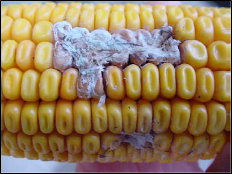Fusarium Kernel Rot
Fusarium Ear Rot
Symptoms
The more common ear rots occurring in Kentucky include: Stenocarpella (Diplodia) ear rot and Fusarium ear rot. Fusarium kernel or ear rot usually infects only individual or groups of kernels scattered over the ear. Salmon-pink to reddish-brown discoloration occurs on the kernels, especially in areas that have been damaged by corn earworms

Fusarium ear or kernel rot
Paul Vincelli, University of KY
or corn borers.
Fusarium ear rot is of particular concern because it may contain fumonisins, mycotoxins that can produce fatal conditions in swine and horses.
Cause
Ear rots are caused by the fungus Fusarium moniliforme. Injury to kernels may favor this disease.
IPM Techniques
- Observe for ear rot from dough stage through harvest.
- Choose hybrids in which ears are well- covered by husks, and which mature with ears pointing downward.
- Clean bins before storage.
- Harvest at about 25% moisture followed by drying to 15% moisture within 24-48 hours for shelled corn to minimize kernel damage and field losses.
References and Additional Information
- IPM-2 Kentucky IPM Manual for Corn
- PPA-10a Kentucky Plant Disease Management Guide for Corn and Sorghum, P. Vincelli and D.E. Hershman, Extension Plant Pathology, University of Kentucky
Compendium of Corn Diseases.M.C. Shurtleff. The Amer. Phytopathol. Soc. 1980.


